By Dr. Mindy Pelz
Menopause, often shrouded in uncertainty and discomfort, is a process that many women find themselves unprepared for. This gap in understanding is not a personal oversight, but a reflection of a broader lack of accessible and credible education on the subject.
Even many health care professionals are grossly uninformed about perimenopause and menopause, and how to help their patients transition gracefully through this stage of life. Seeing as it affects over half the world’s population, you would think it would be a mandatory topic in medical schools. Sadly, only about 58% of medical textbooks talk about menopause at all, while another 12% dedicate only a paragraph to it. And many medical schools don’t even require menopause as part of their mandatory course of study.
This lack of support and resources can leave many women facing the physical and emotional shifts of menopause with more questions than answers. Luckily, some of the answers lie within our diet and lifestyle — meaning women have powerful resources to help them navigate menopause, balance hormones, and maintain their health during one of the biggest transitions of their lives.
In this article, we’ll look at what menopause and perimenopause are, some of the challenges they present, as well as what you can do to get through these hormonal changes with ease.
What Is Menopause?
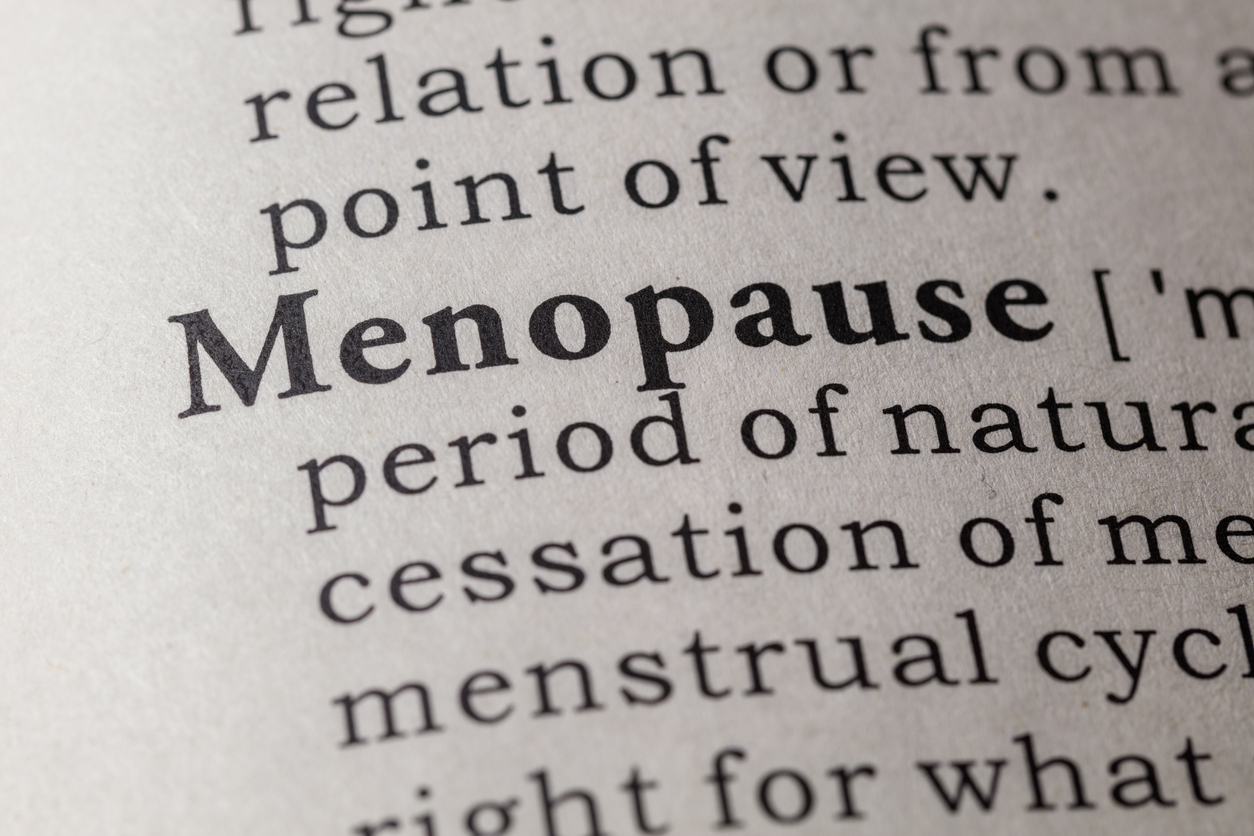
Menopause is a natural transitionary phase in every woman’s life. It usually begins between ages 45 and 55, and marks the end of fertility.
During menopause, the ovaries gradually stop releasing eggs. Typically, menopause is defined as not having a period for 12 months or longer. And with it comes a more than 90% decrease in the sex hormones estrogen and progesterone.
Menopause can be a scary time. Along with puberty, it’s the biggest hormonal change in a woman’s life and can usher in a number of challenging symptoms.
Menopause is also an emotionally difficult time for a lot of women. It marks a shift in identity and a transition into a new phase of life that can be hard to navigate. But remember: Every single woman goes through menopause. It’s a natural part of life, and you’re not alone if you’re dealing with it.
The good news is that with the right tools and perspective, you may be able to move through menopause with grace — and feel healthy and happy as you enter a new chapter of your life.
What Is Perimenopause?
Perimenopause is the beginning of the menopause transition. It usually starts around age 40 and involves changes in menstrual flow and cycle length.
Some women may also experience minor, early symptoms of menopause, like hot flashes and trouble sleeping. These are the result of surges and dips in estrogen and progesterone levels as the ovaries prepare to enter menopause and stop producing eggs.
Symptoms of Menopause and Perimenopause
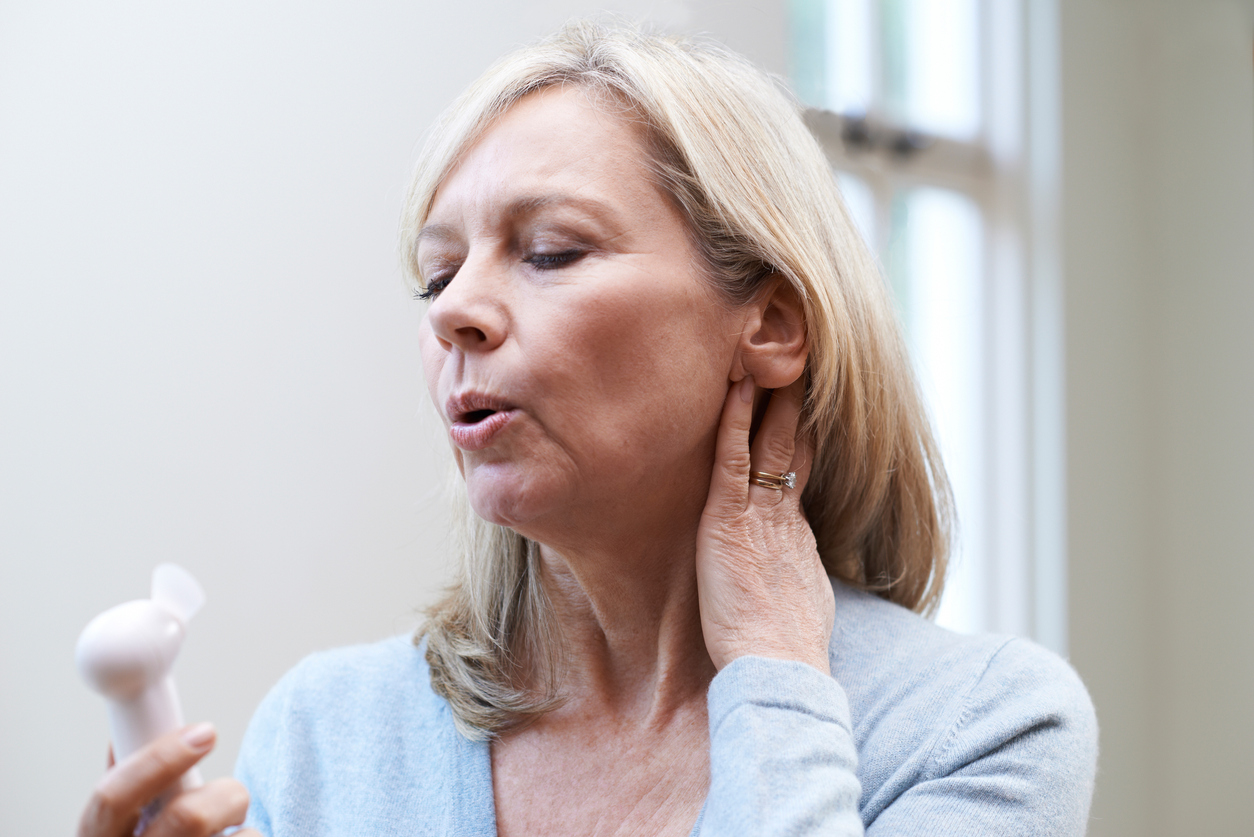
The challenging symptoms of menopause and perimenopause are similar, though they’re usually milder during perimenopause.
Women typically experience some combination of these symptoms during menopause or perimenopause:
- Irregular or absent periods
- Night sweats
- Hot flashes
- Thinning hair
- Sudden weight gain
- Trouble sleeping
- Aches, pains, and cramping
- Increased blood pressure
- Loss of bone density
- Vaginal dryness
- Decreased libido
- Brain fog
- Irritability
- Depression
- Anxiety
- Fatigue
If you’re experiencing a lot of the above, it can feel like you’ve suddenly lost control of your health, which can be scary.
The good news is that there’s a lot you can do to manage menopause and perimenopause naturally. Your diet and lifestyle play a huge role in hormonal balance, and with a few changes, you can reverse many menopause symptoms and reclaim more of your well-being.
How a Plant-Based Diet Can Help Manage Menopause
Diet has a huge impact on hormone levels. And research shows that eating the right foods can make a big difference in how someone feels during menopause.
During menopause, estrogen and progesterone levels decrease. But the right foods can mitigate some of these effects, increasing and balancing your estrogen and progesterone levels while relieving some menopause symptoms.
Foods that Support Estrogen Production
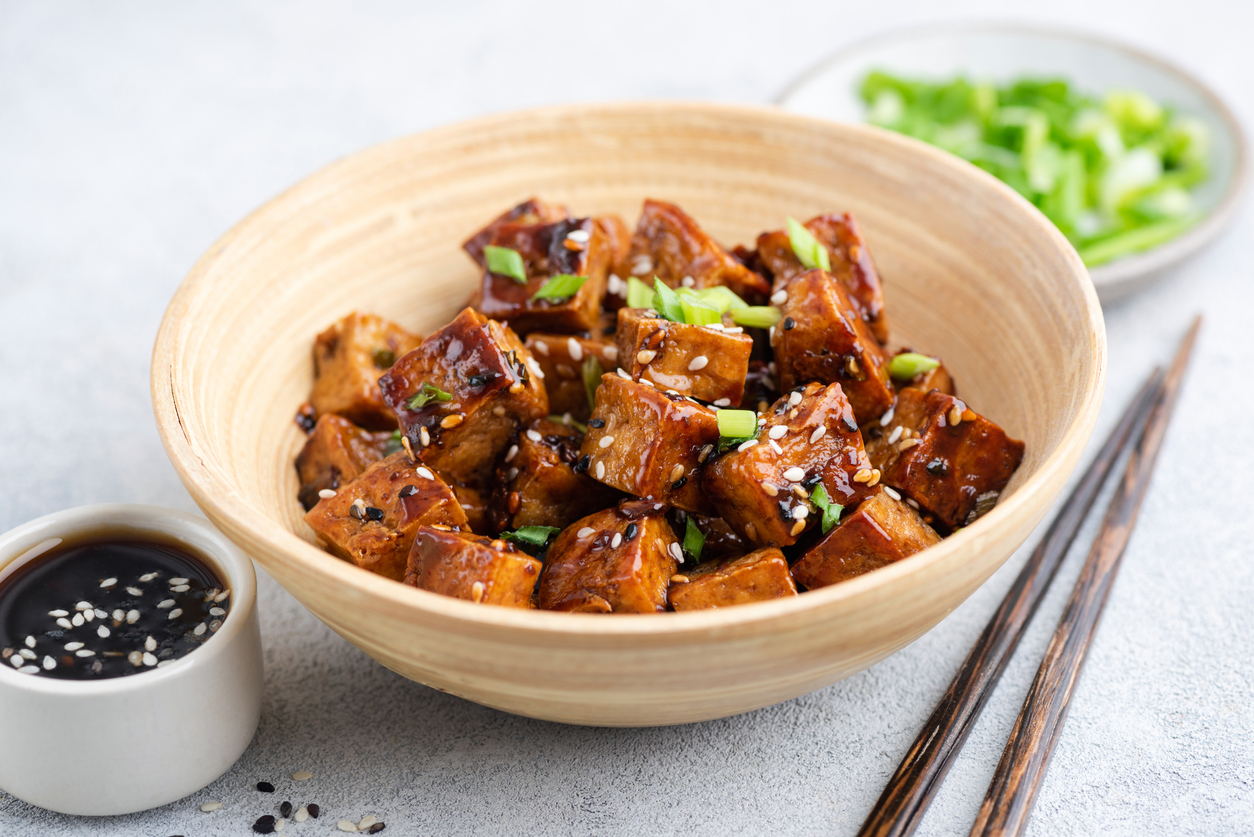
If your estrogen levels are dropping, you may want to eat foods that are high in phytoestrogens — compounds that bind to estrogen receptors and mimic an increase in estrogen levels. A 2021 review found that eating more phytoestrogens reduced many of the challenging symptoms of menopause.
Here are a few foods that can help boost your phytoestrogen levels.
- Flaxseeds are very high in phytoestrogens called lignans. Grind flaxseeds into flax meal to get the most of these beneficial phytoestrogens.
- Sesame seeds are also high in phytoestrogens. A 2006 study found that eating ground sesame seeds daily increased estrogenic activity in postmenopausal women.
- Soy contains a rich source of phytoestrogens called isoflavones. Be sure to choose organic soy when possible to avoid GMOs. Forms of soy with isoflavones include:
-
- Soybeans
- Edamame
- Tofu
- Tempeh
- Soy nuts
- Soymilk
- Miso
- Natto
- Dried apricots are high in a wide variety of phytoestrogens as well. Dried fruit is also a good source of fiber, which can contribute to wider microbial diversity — lessening the impact of menopause.
- Broccoli and Brussels sprouts are both high in a number of phytoestrogens. Along with soy, cruciferous vegetables contain isoflavones that lower the odds of experiencing unpleasant menopause symptoms.
Eating the above foods on a regular basis can help you increase your estrogen levels naturally, balancing low levels of hormones and relieving symptoms of menopause.
Foods that Support Progesterone Production

Much like phytoestrogens increase estrogen, there are compounds called phytoprogestins that mimic progesterone, effectively increasing your progesterone levels.
There are four main phytoprogestins found in food: kaempferol, apigenin, luteolin, and naringenin. All of them can be great for boosting progesterone levels.
Here’s a list of foods that are high in phytoprogestins, according to the USDA database on nutrient content in foods.
Kaempferol
Apigenin
Luteolin
Naringenin
- Grapefruit
- Sour orange
- Cherries
- Dark chocolate
- Tomato
Eating more of these foods can be a great way to support your health and happiness — especially if your progesterone levels are dropping. You’ll be surprised by how much better you feel when you include foods high in phytoprogestins in your daily meals.
Recipes to Help with Menopause and Perimenopause
(From FRN’s lead dietitian and recipe developer, Nichole Dandrea-Russert, RDN)
Navigating the ups and downs of menopause and perimenopause might seem challenging, but supporting your health through nutrition can be simple and enjoyable. Plant-based foods are packed with beneficial phytonutrients that can help make your transition into perimenopause and menopause smoother. And the greatest part? They’re delicious, too!
Enjoy these hormone-balancing recipes and embrace the benefits of a plant-based diet as you move into this new phase of life with increased energy and vitality.
1. Dark Cherry Smoothie Bowl
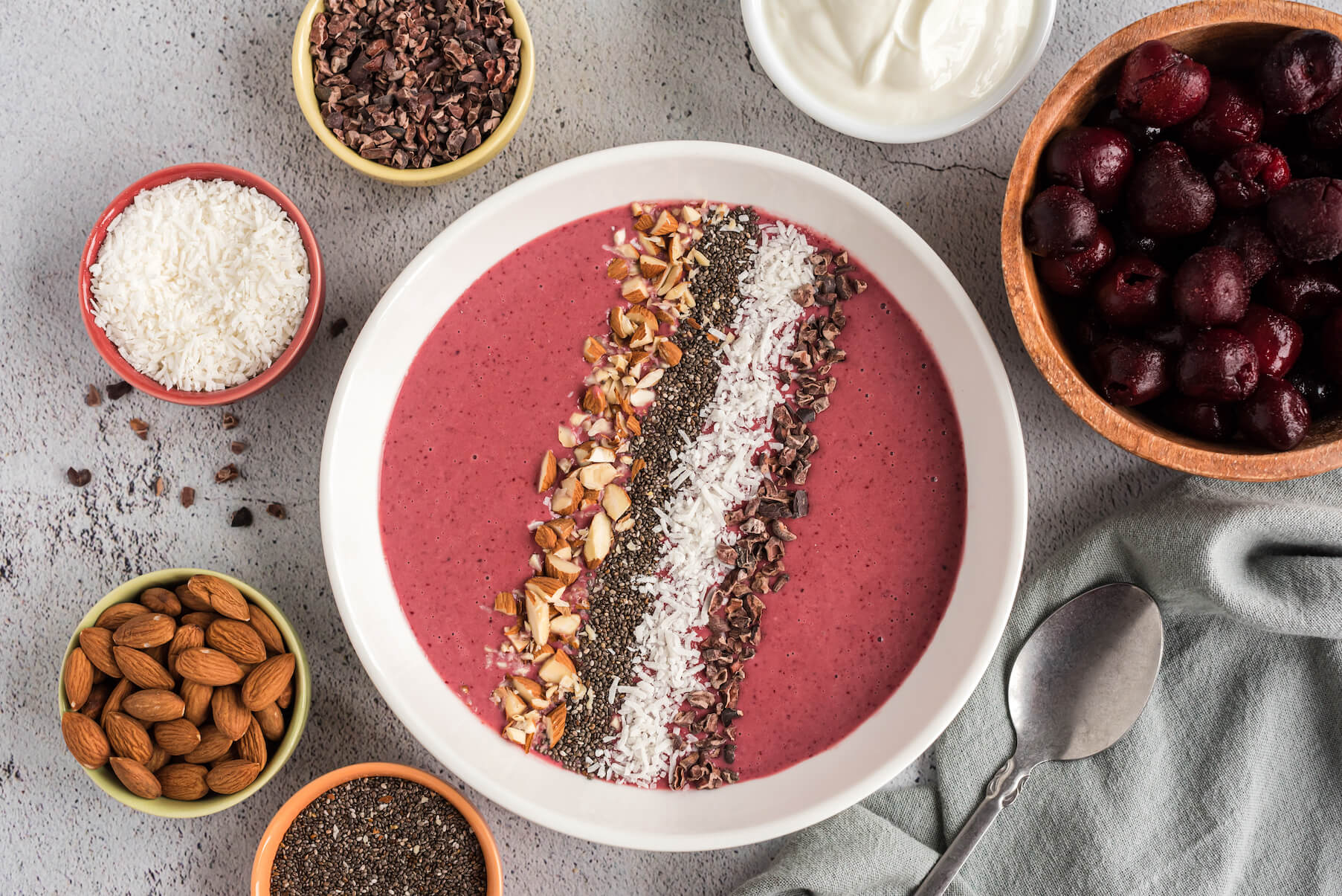
Rich in naringenin, tart cherries are packed with phytoprogestins, making this smoothie bowl a hormone-supporting powerhouse! Although it may not stop your progesterone levels from decreasing entirely, your symptoms may greatly improve, leaving you feeling more like yourself again. Plus, with wholesome plants on your side, you may feel that there is something almost magical about the combination of tart dark cherries, chia seeds, and almonds — not to mention it’s a delicious treat to enjoy first thing in the morning or as a seemingly indulgent bedtime treat.
2. Kale Caesar with Tofu Croutons

Kale Caesar with Tofu Croutons is a rich source of phytoestrogens, primarily thanks to the crunchy tofu croutons and creamy cashew-based Caesar dressing. Plus, between the Caesar dressing, nutty walnut parmesan, crunchy tofu croutons, and vibrant dark green leafy kale, this recipe is brimming with nutrients such as B vitamins, omega-3s, iron, calcium, and magnesium — which all support a healthy transition into menopause. This wholesome salad is a great go-to meal when you’re looking for something consistent to enjoy as your body adjusts to a new way of being.
3. Soothing Chickpea Soup with Fresh Thyme and Oregano
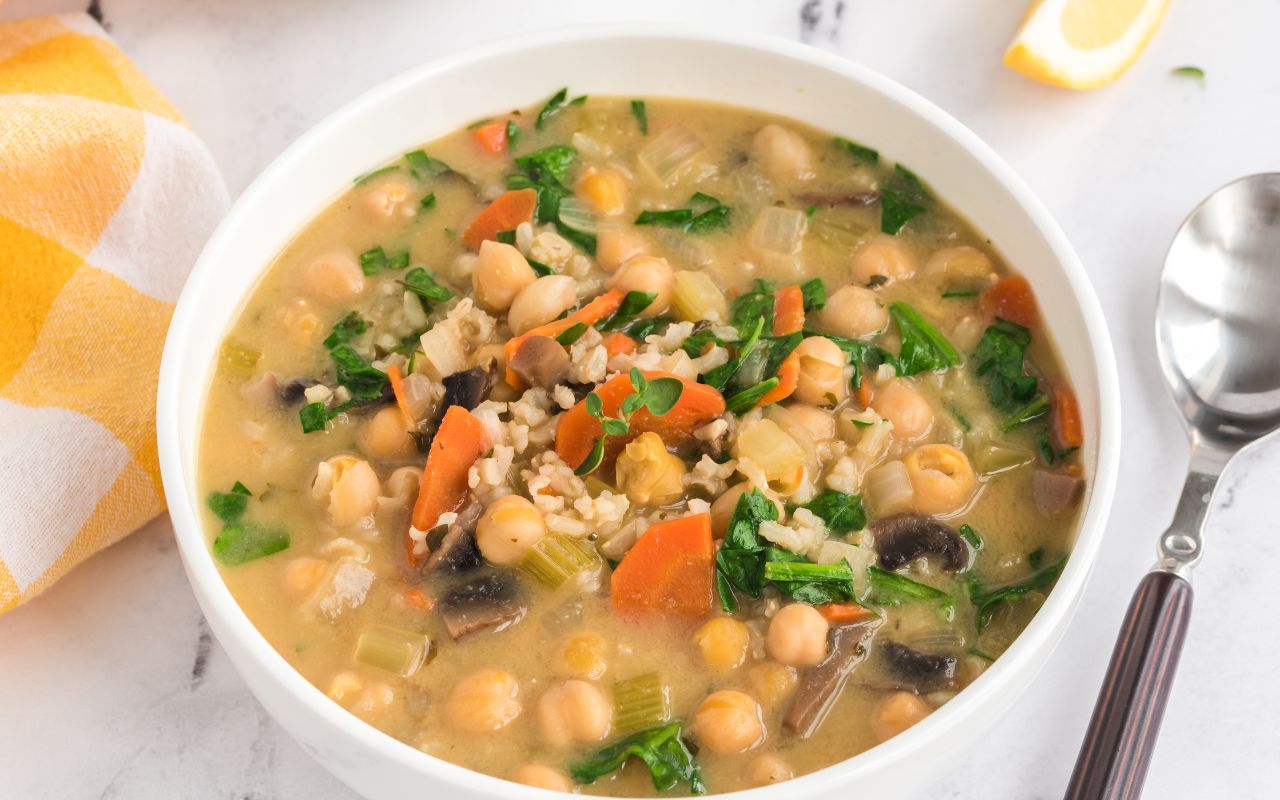
Herbs are your friend during the transitionary period into menopause. As your hormone levels fluctuate, herbs such as thyme and oregano can help to reduce the impact of shifting estrogen and progesterone levels. Enter Soothing Chickpea Soup with Fresh Thyme and Oregano. In addition to the hormonal support, this soup couldn’t be more flavorful, with its fresh thyme and oregano imparting their concentrated, earthy flavors to the chickpeas and rice. Because of its high fiber and plant-based protein content, Soothing Chickpea Soup with Fresh Thyme and Oregano is a satiating and nourishing bowl of comfort that is good for the body and soul.
4. Broccoli and Tomato Pasta Bake

If you’re a fan of broccoli, you’ll be pleased to know that it can be especially beneficial during perimenopause and menopause. Broccoli, along with its cruciferous vegetable siblings, is a helpful support for hormonal health by promoting healthy estrogen levels. These veggies help in maintaining hormonal balance, reducing uncomfortable symptoms of perimenopause and menopause. You can dive into the benefits of these nutrient-rich plants by trying them in dishes like this creamy, cheesy, and savory Broccoli and Tomato Pasta Bake. Not only will you be treating your taste buds, but you’ll also be supporting your body through significant hormonal changes — and that sounds like a win to us!
5. Matcha Green Tea Chia Pudding
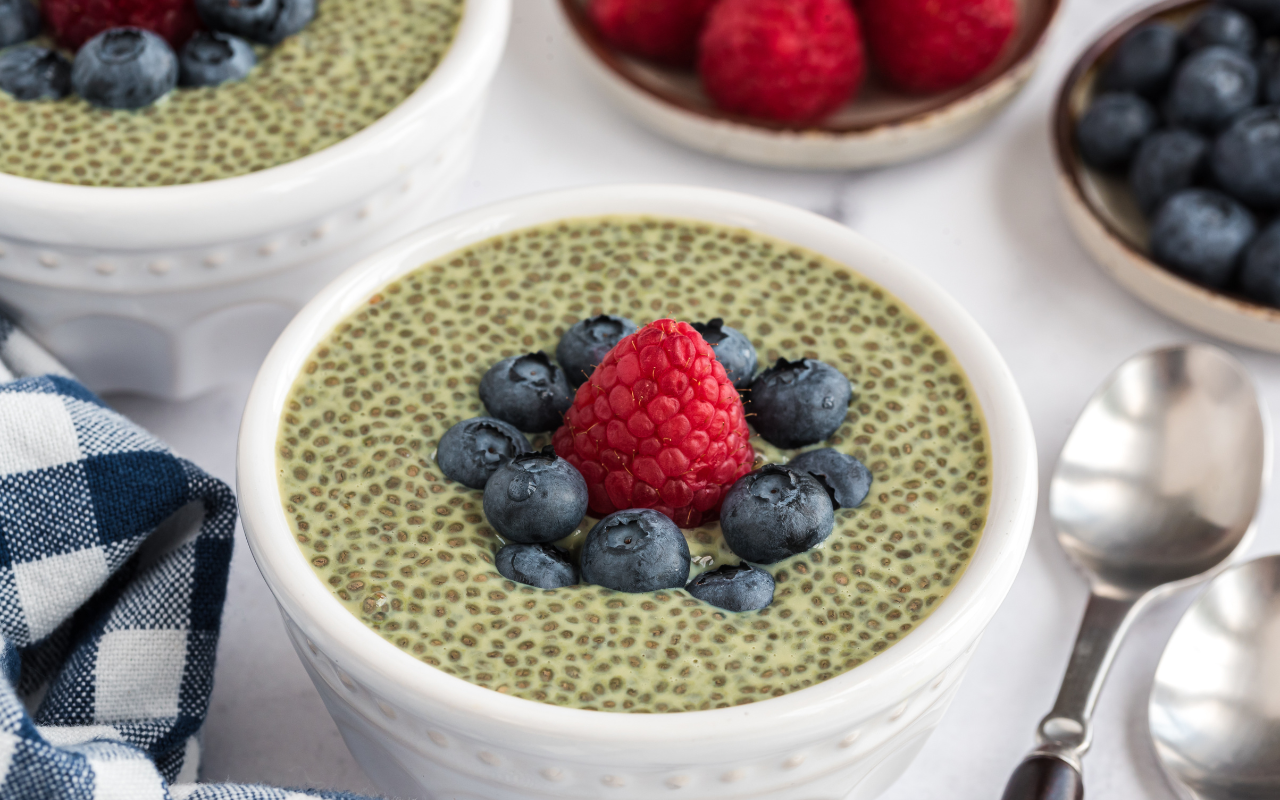
Matcha is powered with catechins that can improve perimenopause and menopause symptoms, especially inflammation, brain fog, and weight gain. Not only that, if you consume green tea regularly (the earlier in your menopause journey, the better), it may even help improve your bone health before you reach the postmenopausal state. So whether you make a soothing cup of matcha green tea or you enjoy it in this fiber-packed Matcha Green Tea Chia Pudding, including green tea in your diet can be a nourishing way to support your health and hormones.
Final Thoughts on What to Eat for Menopause
Menopause can be a challenging time — but a few simple changes to what you eat can make a HUGE difference in how you feel.
Adding the above foods to your diet could help relieve menopause and perimenopause symptoms and support your natural hormone production, giving your body what it needs to feel its best, at every stage of life.
Tell us in the comments:
- Are you going through or have you gone through menopause or perimenopause?
- If you’ve already gone through one or both, what helped you?
- Which foods or recipes will you implement to help with hormonal balance?
Featured Image: iStock.com/Andrii Zastrozhnov

